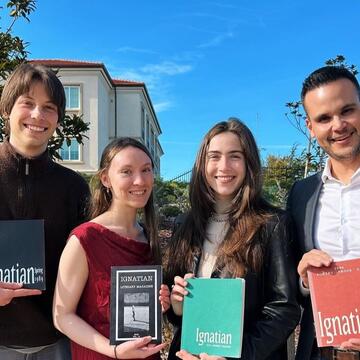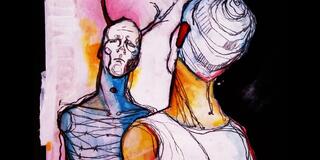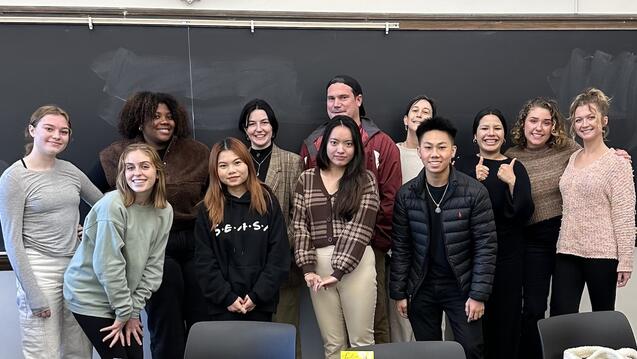
Research Team Opens Literary Time Capsule

English Professor Omar F. Miranda and three undergraduate students set out earlier this year to find the untold story of USF’s literary magazine, which has been published for more than a century.
They found poetry by nuns, who were the first women published in the magazine in the 1940s, as well as a poem by Gordon Getty ’56. They found an article about the Titanic sinking in 1912, two years after the magazine was founded. And an essay by American physicist Herman Kahn.
They found comic strips, musical compositions, and a piece of prose written in 1927 by Edward Sullivan ’28 called “San Francisco By Night,” an ode to the city and the neighborhood around USF.

“I’ve been wanting to do this for a while,” said Miranda, faculty adviser for Ignatian Literary Magazine. “It was a pleasure to work with three fantastic students who wanted to collaborate and do the kind of investigative work we thoroughly enjoy anyway in the literature classroom.”
The literary magazine was started at USF in 1910 to celebrate students’ writing and literary works. Along the way it has become a documented history of the university, with student writing reflecting two world wars, the Great Depression, and political turmoil in the 1960s.
Jacob Bloom ’23, Mallory Shafer ’24, and Audrey Walker ’24 worked with Miranda during the spring semester in the Donohue Rare Book Room at Gleeson Library, reviewing about 80 issues of the magazine, both in print and digital form, from 1910 through 2023. They were aided by Gleeson’s special collections and university archives team headed by Annie Reid.
“There were different accounts of Ignatian’s history that were just inconsistent,” Miranda said. “I knew we had to dig into the material ourselves and do some sleuthing.”
The magazine has had a few different names over the decades, including Ignatian, San Francisco Quarterly, and Gaviota. It has also shared differing beliefs over the years, including views Bloom described as “hateful.”
“How should we acknowledge this side of the magazine’s history?” Bloom said. “Ultimately, we decided that acknowledging the ideologies that appeared in the magazine in decades past was important and necessary. With that in mind, we also tried to highlight the content from the more recent issues that we felt proud of.”
The result? A new digital history of the literary magazine that highlights some of the items the students and Miranda found.
“This deep dive into the archives has given us such an appreciation for our campus history,” Miranda said. “It is especially gratifying to learn that the literary arts have been so important and valued across so many decades at USF.”
Ignatian Literary Magazine is student-run and published twice a year now, in a digital format, with a single “compendium” print edition that brings together the best poetry, fiction, creative nonfiction, and visual artwork from the year.
“With this historical knowledge, our students feel more empowered and inspired than ever to carry out the cherished Ignatian literary tradition,” Miranda said. “For them, the written word matters, and they have created such an impressive professional setting where various teams work tirelessly to promote and publish the best poetry and prose possible. It is a privilege for me to serve as their adviser.”


